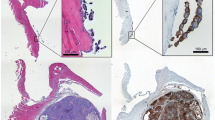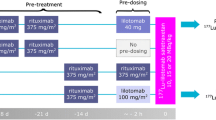Abstract.
In this study the potential of intraperitoneal (i.p.) and intravenous (i.v.) administration of chimeric iodine-131-labelled MOv18 IgG for radioimmunotherapy was determined. The dosimetry associated with both routes of administration of cMOv18 IgG was studied in patients. Eight patients suspected of having ovarian carcinoma received 150 MBq 131I-cMOv18 IgG i.p. Blood and urine were collected and serial gamma camera images were acquired. Another group of four patients received 7.5 MBq 131I-cMOv18 IgG i.v. For all patients, tissue biopsies were obtained at surgery. Activity in the blood after i.p. administration was described by a bi-exponential curve with a mean uptake and elimination half-life of 6.9±3.2 h and 160±45 h, respectively. For i.v. infusion the mean half-life for the elimination phase was 103±12 h. Cumulative excretion in the urine was 17%±3% ID and 21%±7% ID in 96 h for i.p. and i.v. administration, respectively. Scintigraphic images after i.p. administration showed accumulation in ovarian cancer lesions, while all other tissues showed decreasing activity with time. Tumour uptake determined in the ovarian cancer tissue specimens ranged from 3.4% to 12.3% ID/kg for i.p. administration and from 3.6% to 5.4% ID/kg for i.v. administration. Dosimetric analysis of the data indicated that 1.7–4.3 mGy/MBq and 1.7–2.2 mGy/MBq can be guided to solid or ascites cells after i.p. and i.v. administration, respectively. Assuming that an absorbed dose to the bone marrow of 2 Gy will be dose limiting, a total activity of 4.1 GBq 131I-cMOv18 IgG can be administered safely via the i.p. route and 3.5 GBq via the i.v. route. At this maximal tolerated dose, a maximum absorbed dose to 1-g tumours in the peritoneal cavity of 18 and 8 Gy can be reached after i.p. and i.v. administration, respectively. For the i.p. route of administration, dose estimates for the tumour are even higher when the electron dose of the peritoneal activity is also taken into account: total doses to the tumour of 30 Gy and 22 Gy will be absorbed at the tumour surface and at 0.2 mm depth, respectively. In conclusion, therapeutic tumour doses can be achieved with 131I-cMOv18 IgG in patients with intraperitoneal ovarian cancer lesions with no normal organ toxicity. The i.p. route of administration seems to be preferable to i.v. administration.
Similar content being viewed by others
Author information
Authors and Affiliations
Additional information
Received 10 July and in revised form 17 August 1998
Rights and permissions
About this article
Cite this article
Buijs, W., Tibben, J., Boerman, O. et al. Dosimetric analysis of chimeric monoclonal antibody cMOv18 IgG in ovarian carcinoma patients after intraperitoneal and intravenous administration. Eur J Nucl Med 25, 1552–1561 (1998). https://doi.org/10.1007/s002590050335
Issue Date:
DOI: https://doi.org/10.1007/s002590050335




